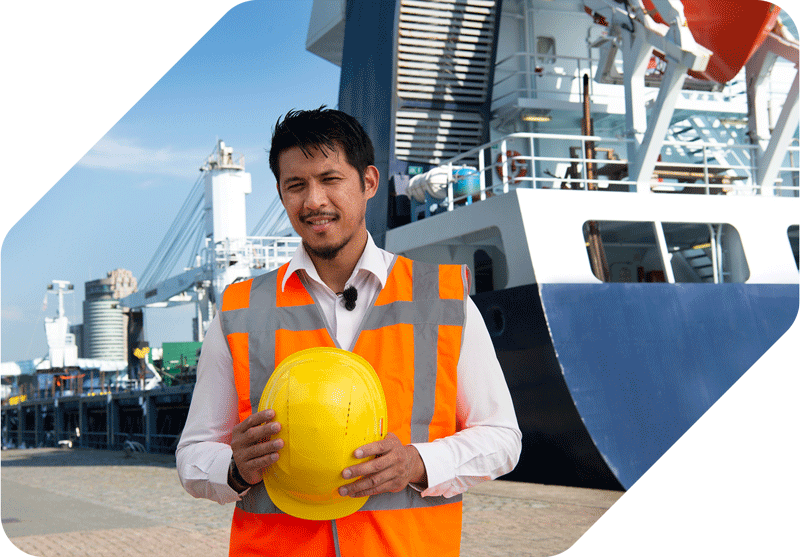Home »
Why employer branding matters in the maritime industry
Frans, founder of Getting the Market, lives and breathes maritime and logistics. He believes every successful marketing effort begins with a sharp analysis.
Ask any maritime HR department, fleet manager or crewing agency what keeps them up at night, and you won’t hear the word ‘marketing’. You’ll hear ‘people’. Finding seafarers. Retaining them. Motivating them to stay for another contract.
Shipping is a competitive industry. The market for seafarers is under pressure. According to BIMCO and ICS, we’re heading towards a shortfall of nearly 90,000 officers by 2026. The Philippines remains the largest supplier of seafarers, followed by India, China, Indonesia and Russia. But attracting people from these countries takes more than a job post and a decent contract.
That’s where maritime employer branding comes in.
It starts with your DNA
What makes your shipping company a great place to work? Not just at sea, but also onshore. What do seafarers and office workers say about your culture, your leadership, your mindset? These are not soft questions. They’re fundamental.
You need to define your employer branding DNA. What kind of team are you building? What behaviours do you reward? And what values should every colleague, from cook to chief engineer, live by? Who are your brand ambassadors? What do they have in common?
Pro tip #1: If you don’t define your DNA, others will. Employer branding is not something you launch. It’s something you shape, every day.
What is an Employer Value Proposition?
Your Employer Value Proposition (EVP) is the set of unique benefits and experiences you offer to current and future employees. It explains what people can expect when they join your company, and why they should choose you over one of your competitors.
A strong EVP answers one key question:
“Why should I work for you?”
To get there, you need to stop thinking like an employer and start listening to your colleagues. What do your people value most? Time off between rotations? A reliable payment schedule? Room to grow into new roles? Or simply being treated with respect?
The best EVPs are not crafted by HR alone. They emerge naturally, expressed by colleagues who feel a true sense of belonging. Built from real stories and genuine experiences, they convey what it’s like to work here every single day. They are honest, clear, and specific. Interviewing your colleagues is fun and an excellent way to gain fresh insights.
Pro tip #2: Don’t build your EVP in a boardroom. Start by talking to your people. Ask them why they stay. Why they leave. What makes the job worthwhile. These answers are your EVP.

Once you have it, use it. Not just in job ads, but across your entire brand. On your website. In your content. In your conversations with crewing agencies. Consistency is key. The best EVPs demonstrate what impact your company has on your staff.
Where do seafarers come from?
The global seafaring workforce is concentrated in a few key nations. If you’re recruiting internationally, this is your playing field:
| Rank | Country | Estimated number of seafarers |
|---|---|---|
| 1 | Philippines | 550,000 (≈ 350,000 ratings + 200,000 officers) |
| 2 | China | ±250,000 |
| 3 | India | ±240,000 |
| 4 | Indonesia | ±180,000 |
| 5 | Russia | ±120,000 |
| 6 | Ukraine | ±100,000 |
| 7 | Greece | ±60,000 |
| 8 | Turkey | ±55,000 |
| 9 | Myanmar | ±50,000 |
| 10 | Vietnam | ±45,000 |
These numbers include both officers and ratings. Ratings are the non-officer crew responsible for key operational roles such as mooring, maintenance, engine room support, cleaning and catering. For most shipowners, these countries are the first stop when building or scaling a crew. But without a clear and attractive employer profile, it’s becoming harder to convince seafarers to sign on.
Building a globally relevant EVP
Creating an EVP is one thing. Making sure it works across borders is something else entirely.
An EVP that appeals to a Filipino deck officer might not resonate in the same way with a Ukrainian engineer or a Greek superintendent. Different cultures bring different values, expectations and communication styles. Some prioritise stability and family leave. Others value career growth, salary or social status.
So how do you build an EVP that works internationally?
Start by listening locally. Involve people from different regions and backgrounds when developing your message. What matters most to them? What do they need to feel supported? Your goal is not to write ten different EVPs, but to create core messages with room for local adaptation.
Language adds another layer. Many seafarers speak English, but that doesn’t mean they process nuance the same way. Use plain and simple language. Avoid wordplay, jargon or cultural references that don’t travel well. When needed, translate your materials, not just word for word, but with attention to tone and meaning.
The most effective employer brands feel both consistent and personal. They tell one story, in multiple voices.
Pro tip #3: Start with one EVP. Test it in different countries and adapt accordingly. Refine your tone and delivery, not your message. That’s how you stay true to your brand and relevant to your audience.

Managing global teams
Shipping crews often include a dozen nationalities on one vessel. That demands more than good intentions. It calls for empathy, leadership and clear communication. It also calls for a culture where people feel respected, seen and supported, regardless of background. In the end it is about a sense of belonging, built upon a shared set of values.
Pro tip #4: Employer branding isn’t just about attracting talent. It also helps you lead better. Use it to guide how you onboard, train and support your teams. The clearer your brand, the more connected your crew.
A strategic edge
Seafarers talk. Agencies compare notes. Word spreads fast in shipping. If you want to attract and retain the right people, you need more than a recruitment pipeline. You need a brand that people recognise, trust and want to be part of.
At Getting the Market, we help shipping companies define and express their employer brand. It starts by embracing the unsolicited brand ambassadors. Identify them and capture their stories. Through positioning, storytelling and smart content strategies we you’re your employer branding come to life. Want to get the conversation started?

“Download the 7-Step Action Plan to build your own Maritime Employer Value Proposition. Or contact me.”
Frans Swarttouw
B2B Marketeer & Growth Seeker
